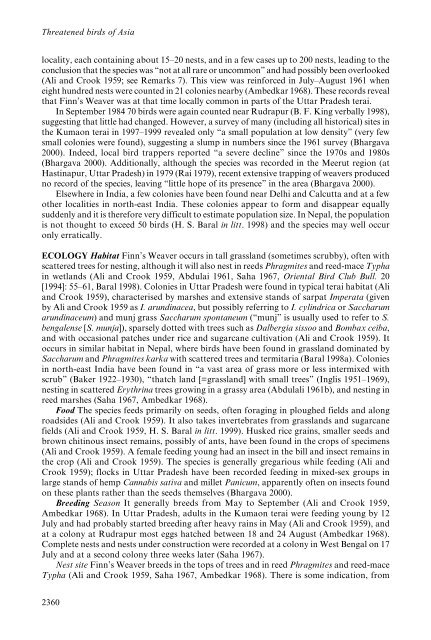Threatened Birds of Asia: - BirdLife International
Threatened Birds of Asia: - BirdLife International
Threatened Birds of Asia: - BirdLife International
You also want an ePaper? Increase the reach of your titles
YUMPU automatically turns print PDFs into web optimized ePapers that Google loves.
<strong>Threatened</strong> birds <strong>of</strong> <strong>Asia</strong><br />
locality, each containing about 15–20 nests, and in a few cases up to 200 nests, leading to the<br />
conclusion that the species was “not at all rare or uncommon” and had possibly been overlooked<br />
(Ali and Crook 1959; see Remarks 7). This view was reinforced in July–August 1961 when<br />
eight hundred nests were counted in 21 colonies nearby (Ambedkar 1968). These records reveal<br />
that Finn’s Weaver was at that time locally common in parts <strong>of</strong> the Uttar Pradesh terai.<br />
In September 1984 70 birds were again counted near Rudrapur (B. F. King verbally 1998),<br />
suggesting that little had changed. However, a survey <strong>of</strong> many (including all historical) sites in<br />
the Kumaon terai in 1997–1999 revealed only “a small population at low density” (very few<br />
small colonies were found), suggesting a slump in numbers since the 1961 survey (Bhargava<br />
2000). Indeed, local bird trappers reported “a severe decline” since the 1970s and 1980s<br />
(Bhargava 2000). Additionally, although the species was recorded in the Meerut region (at<br />
Hastinapur, Uttar Pradesh) in 1979 (Rai 1979), recent extensive trapping <strong>of</strong> weavers produced<br />
no record <strong>of</strong> the species, leaving “little hope <strong>of</strong> its presence” in the area (Bhargava 2000).<br />
Elsewhere in India, a few colonies have been found near Delhi and Calcutta and at a few<br />
other localities in north-east India. These colonies appear to form and disappear equally<br />
suddenly and it is therefore very difficult to estimate population size. In Nepal, the population<br />
is not thought to exceed 50 birds (H. S. Baral in litt. 1998) and the species may well occur<br />
only erratically.<br />
ECOLOGY Habitat Finn’s Weaver occurs in tall grassland (sometimes scrubby), <strong>of</strong>ten with<br />
scattered trees for nesting, although it will also nest in reeds Phragmites and reed-mace Typha<br />
in wetlands (Ali and Crook 1959, Abdulai 1961, Saha 1967, Oriental Bird Club Bull. 20<br />
[1994]: 55–61, Baral 1998). Colonies in Uttar Pradesh were found in typical terai habitat (Ali<br />
and Crook 1959), characterised by marshes and extensive stands <strong>of</strong> sarpat Imperata (given<br />
by Ali and Crook 1959 as I. arundinacea, but possibly referring to I. cylindrica or Saccharum<br />
arundinaceum) and munj grass Saccharum spontaneum (“munj” is usually used to refer to S.<br />
bengalense [S. munja]), sparsely dotted with trees such as Dalbergia sissoo and Bombax ceiba,<br />
and with occasional patches under rice and sugarcane cultivation (Ali and Crook 1959). It<br />
occurs in similar habitat in Nepal, where birds have been found in grassland dominated by<br />
Saccharum and Phragmites karka with scattered trees and termitaria (Baral 1998a). Colonies<br />
in north-east India have been found in “a vast area <strong>of</strong> grass more or less intermixed with<br />
scrub” (Baker 1922–1930), “thatch land [=grassland] with small trees” (Inglis 1951–1969),<br />
nesting in scattered Erythrina trees growing in a grassy area (Abdulali 1961b), and nesting in<br />
reed marshes (Saha 1967, Ambedkar 1968).<br />
Food The species feeds primarily on seeds, <strong>of</strong>ten foraging in ploughed fields and along<br />
roadsides (Ali and Crook 1959). It also takes invertebrates from grasslands and sugarcane<br />
fields (Ali and Crook 1959, H. S. Baral in litt. 1999). Husked rice grains, smaller seeds and<br />
brown chitinous insect remains, possibly <strong>of</strong> ants, have been found in the crops <strong>of</strong> specimens<br />
(Ali and Crook 1959). A female feeding young had an insect in the bill and insect remains in<br />
the crop (Ali and Crook 1959). The species is generally gregarious while feeding (Ali and<br />
Crook 1959); flocks in Uttar Pradesh have been recorded feeding in mixed-sex groups in<br />
large stands <strong>of</strong> hemp Cannabis sativa and millet Panicum, apparently <strong>of</strong>ten on insects found<br />
on these plants rather than the seeds themselves (Bhargava 2000).<br />
Breeding Season It generally breeds from May to September (Ali and Crook 1959,<br />
Ambedkar 1968). In Uttar Pradesh, adults in the Kumaon terai were feeding young by 12<br />
July and had probably started breeding after heavy rains in May (Ali and Crook 1959), and<br />
at a colony at Rudrapur most eggs hatched between 18 and 24 August (Ambedkar 1968).<br />
Complete nests and nests under construction were recorded at a colony in West Bengal on 17<br />
July and at a second colony three weeks later (Saha 1967).<br />
Nest site Finn’s Weaver breeds in the tops <strong>of</strong> trees and in reed Phragmites and reed-mace<br />
Typha (Ali and Crook 1959, Saha 1967, Ambedkar 1968). There is some indication, from<br />
2360
















